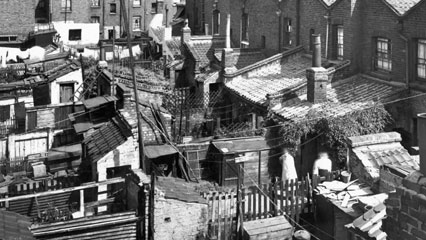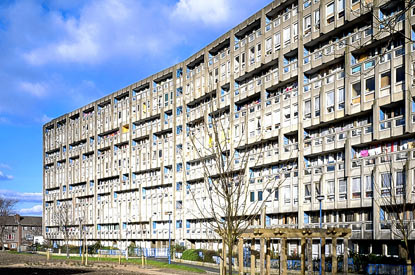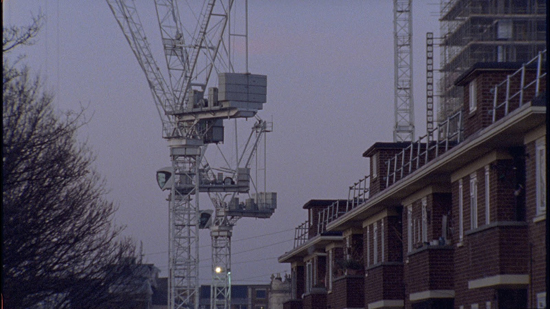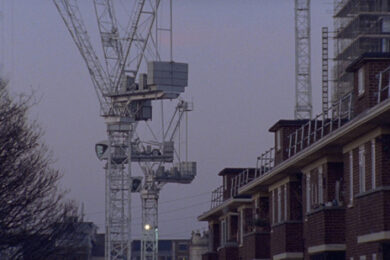At this year’s always excellent East End Film Festival, the hot button issues of gentrification, local communities and housing, while not an explicit strand, found its way into several of the locally produced and focused films. "Urban Regeneration" cast a long shadow over the proceedings like, well, a giant high-rise apartment block over a local community market. With the Olympics looming, East London Line recently completed and Dalston Square Tower recently open for business, it’s natural to talk about how the built environment is impacting this rapidly changing area of Hackney and Tower Hamlets. Here’s a few of the provocative films the Quietus checked out:
Surprisingly for a local film festival, the screening of Under the Cranes at the historic Rio Cinema was packed full of film fans, local residents and randoms coaxed in off the street by local writer Michael Rosen – whose play the film is based on. Rosen’s disembodied voices talk both frankly and poetically, through a thick east end drawl, about Hackney while archive footage and gently wandering tracking shots paint the scene, much like Patrick Keiller’s London, an obvious reference point. This is mixed with more classic documentary history including striking images and stories of the Mosely race riot.
Under the Cranes is perhaps the wrong title. Those expecting a cogent, detailed argument about urban regeneration and the fate of inner city neighbourhoods may be disappointed. Although specific reference is made to the Dalston Square development ("Childless Towers" which were pushed through planning despite local residents protests) urbanism is not the focus here. Under the Cranes sits much better with the recent explosion of work, such as Ian Sinclair’s book Hackney, That Rose Red Empire, last year’s London Preambulator and The Four Aces, which document and in various ways lament the demise of the East End Borough. But in this context, it is certainly one of the stronger entries because it gives a sense of Hackney’s resilience and latent potential instead of another pre-emptive obituary.
The film wants to demonstrate that, following a quote from Jane Jacobs, "…lively, diverse, intense cities contain the seeds of their own regeneration." But while Jacobs, in her book The Death and Life of Great American Cities appeals to your common sense, Under the Cranes is an argument to your emotions. Old grainy super 8 footage seems to invest even the most mundane scenes with a bitter-sweet glow (though the ubiquitous hipstamatic filter is starting to cheapen this effect). When these images are paired with sparse piano or classical guitar (and beatboxing and Toumani Diabate) you’ve got a guaranteed tearjerker.
But as the director contends, this film is not about nostalgia. The film finds beauty in trash collecting, and places modern scenes next to old. There is no contrast between a working-class past shown through rose-tinted glasses and a gentrified present shown through hip Raybans. There is continuity: there were problems before and different problems now.

On the Sunday, after an engaging documentary short about a successful squatter community turned housing cooperative, Bonnington Square, we were treated to a film very much at the other end of the spectrum from Cranes. 14th Floor is a detached, painstakingly historical account of council housing in the neighbouring borough of Tower Hamlets.
The film feels a bit haphazardly put together at times: we see high quality shots of the estates, replete with artistically timed birds flying past the camera, which do their very best to make some very dour buildings look magestic; but then there are awkwardly edited interviews filmed on a shakey camcorder and some sub-powerpoint graphics. But technique is not the point, of course: 14th Floor is a historical document telling an untold history and, along the way, reminding us of a time when the duty of the state to provide housing options for its workers was not really in question. Many of the talking heads, who work in the social housing industry, actually grew up in council flats and want to give back in some way.
But while 14th Floor is an interesting watch if you have any association with East London, it’s clearly quite difficult to make a film about housing ‘riviting’. This is also why you don’t get films telling structural, David Harvey-type accounts of the spatial accumulation of capital. But it is precisely the labyrinthine nature of planning, law and urban economics which prevents outraged local communities, however well organised, from fighting against the developers. No one can grasp the big picture. (One of the very best, and most entertaining expose’s of urban development is Emily Jame’s Battle for Broadway Market which you can watch here.)

On the EEFF’s Movie May Day, the good people at the London Short Film Festival screened a selection of shorts – one of which, called Robin Hood Gardens [or every brutalist structure for itself] made some efforts to bridge the emotional with the intellectual. The film concerns the famous housing block by Alison and Peter Smithson, a utopian vision for working class housing which is today a council estate in disrepair. The council wants to sell the land to build middle class apartments, but this time it’s the architectural community that is up in arms – looking to preserve what they see as a historically important ‘brutalist’ masterpiece.
The film features well composed, panoramic shots of the building and entertaining interviews with players on all sides the debate. We see a security guard wrestling with a defiant elevator, a painter describing the building, an exasperated MP and an architectural historian. In this context it is disquieting to hear the historian make statements about grand sweeps of the facade or contrasting textures when the fate of hundreds of residents, mostly Bangali families, is at stake – either living with sub-par housing or being relocated. It’s almost like the reverse of that scene in the Fountainhead when Ayn Rand’s architectural hero, played by Gary Cooper in the film, decides to blow up three perfectly habitable tower blocks when they are not realized to his exacting aesthetic standards. Robin Hood Gardens, humorous and winking in its portrayal of the crisis very appropriately ends with several solemn residents at home. Other then a very sleepy community meeting, they don’t say very much because their voices don’t particular register above all the din.
While we’ve yet to see the film that makes a definitive statement on the rapidly changing East End, the problem of how to regenerate an area without pricing out the original residents is still unresolved by academics, planners and economists. But all these films, in different ways, contribute to an awareness of the issues involved. Giving the East End a sense of history and place which can’t so easily be paved over.



